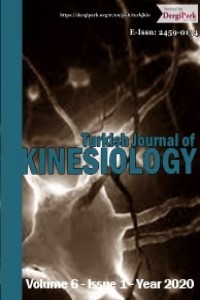Improvement of the motor and functional capacity of post-cerebrovascular accident hemiplegics by exercise retraining combined with a varied exercises program
Motor and functional capacity, hemiplegia, exercise retraining, varied physical exercises
Improvement of the motor and functional capacity of post-cerebrovascular accident hemiplegics by exercise retraining combined with a varied exercises program
Motor and functional capacity, hemiplegia, exercise retraining, varied physical exercises,
___
- Adoukonou, T. A., Vallat, J-M., Joubert, J., Macian, F., Kabore, R., Magy, L., Houinato, D., & Preux, P.-M. (2010). Prise en charge des accidents vasculaires cérébraux en Afrique subsaharienne. Rev Neurol, 166(11), 882-893.
- Barbeau, M., Lord, S. E., Rochester, L., Weatherall, M., McPherson, K. M., & McNaughton, H. K. (2006). The effect of environment and task on gait parameters after stroke: a randomized comparison of measurement conditions. Arch Phys Med Rehabil, 87(7), 967-973.
- Bohannon, R. W. (1987). Gait performance of hemiparetic stroke patients: selected variables. Arch Phys Med Rehabil, 68(11), 777-781.
- Bourgeais, A. L., Guay, V., Laraudie, L., Marsal, C., & Thevenin-Lemoine, E. (2009). Information booklet and self-rehabilitation program following a stroke for caregivers intended for hemiplegic people. HPST Law, 21, L.1161-1-L.
- Chaudhuri, A., & Behan, P. O. (2004). Fatigue in neurological disorders. Lancet, 363(9413), 978‑988.
- Courbon, A., Calmels, P., Roche, F., Ramas, J., & Fayolle-Minon, I. (2006). Relationship between walking capacity and maximal exercise capacity, strength and motor deficiency in adult hemiplegic stroke patients. Ann Phys Med Rehabil, 49(8), 614-620.
- Donovan, K., Lord, S. E., McNaughton, H. K., & Weatherall, M. (2008). Mobility beyond the clinic: the effect of environment on gait and its measurement in community-ambulant stroke survivors. Clin Rehabil, 22(6), 556-563.
- Gallien, P., Adrien, S., Petrilli, S., Durufle, A., Robineau, S., Kerdoncuff, V., … Nicolas, B. (2005). Maintien à domicile et qualité de vie à distance d’un accident vasculaire cerebral. Ann Phys Med Rehabil, 48(5), 225-230.
- Harari, D., Norton, C., Lockwood, L., & Swift, C. (2004). Treatment of constipation and fecal incontinence in stroke patients randomized controlled trial. Stroke, 35(11), 2549‑2555.
- Heyward, V. (2010). Advanced fitness assessment and exercise prescription (6th edition). US: Human Kinetics.
- Johnston, S. C., Mendis, S., & Mathers, C. D. (2009). Global variation in stroke burden and mortality: estimates from monitoring, surveillance, and modelling. Lancet Neurol, 8(4), 345-354.
- Karvonen, M. J., Kentala, E., & Mustala, O. (1957). The effects of training on heart rate: a longitudinal study. Ann Med Exper Fenn, 35, 307–315.
- Kessomtini, W. (2015). Les douleurs de l’hémiplégique vasculaire du diagnostic à la prise en charge thérapeutique. Dl. Eval Diag Trt, 16(1), 32-37.
- Kim, A. S., & Johnston, S. C. (2011). Global variation in the relative burden of stroke and ischemic heart disease. Circulation, 124(3), 314-323.
- Klit, H., Finnerup, N. B., & Jensen, T. S. (2009). Central post-stroke pain: clinical characteristics, pathophysiology, and management. Lancet Neuro, 8(9), 857-868.
- Kusuayi, M. G., Nkiama, E. C., Kiana, N. N., Bongo, N. J. & Kayembe, N. J. M. (2018b). Improvement of the cardiopulmonary capacity of patients with chronic obstructive pulmonary disease of Kinshasa by training of aerobic endurance and resistance. Turk J Kinesiol, 4(4), 149-154.
- Kusuayi, M., Ekisawa, C. N., Delecluse, C., Bompeka, F. L., & Nkodila Natuhoyila, A. (2018a). Evaluation de la prévalence de l’hypertension artérielle de l’adulte en milieu du travail à Kinshasa, République Démocratique du Congo. Science & Sports, 33(4), 213-220.
- Monod-Broca P. (2001). Paul Broca: 1824-1880 [Paul Broca: 1824-1880]. Ann Chir, 126(8), 801–807. O'Donnell, M. J., Chin, S. L., Rangarajan, S., Xavier, D., Liu, L., Zhang, H., … INTERSTROKE investigators (2016). Global and regional effects of potentially modifiable risk factors associated with acute stroke in 32 countries (INTERSTROKE): A case-control study. Lancet (London, England), 388(10046), 761–775.
- Petrilli, S., Durufle, A., Nicolas, B., Pinel, J. F., Kerdoncuff, V., Gallien, P. (2002). Hémiplégie vasculaire et retour à domicile. Ann Readapt Med Phys, 45(2), 69‑76.
- Sibley, K. M., Tang, A., Patterson, K. K., Brooks, D., McIlroy, W. E. (2009). Changes in spatiotemporal gait variables over time during a test of functional capacity after stroke. J Neuroeng Rehabil, 6, 27.
- Tanaka, H., Monahan, K. D., & Seals, D. R. 82001). Age-predicted maximal heart rate revisited. J Am Coll Cardiol, 37 (1) 153–156.
- Toledano, K., Mann, G., Hankey, G. J., Cameron, D. (1999). Swallowing function after stroke prognosis and prognostic factors at 6 months. Stroke, 30(4), 744‑748.
- Truelsen, T. (2010). Stroke incidence studies in Africa. The Lancet Neuro, 9(8), 755–757.
- Walker, R. W., Jusabani, A., Aris, E., Gray, W. K., Mugusi, F., Swai, M., Alberti, K. G., & Unwin, N. (2012). Correlates of short- and long-term case fatality within an incident stroke population in Tanzania. S Afr Med J, 103(2), 107–112.
- Yayın Aralığı: 4
- Başlangıç: 2015
- Yayıncı: Nurtekin Erkmen
The examination of the relationship between body composition and acceleration
İbrahim Halil ŞAHİN, Ahmet SANİOĞLU
Godefroid KUSUAYİ, Carel Busano NDUAKULU, Siloé Ntumba TSHIYAMBA, Constant NKIAMA
Effect of caffeine on the cardiovascular system and performance: A systematic review
Bojan BJELICA, Nikola AKSOVIĆ, Milan ZELENOVİĆ, Radomir PRŽULJ, Oliver RADENKOVİC
The effect of technical training on physical parameters of 11-14 years old freestyle wrestlers
Bihter AKINOĞLU, Hasan Yasin ACAR, Büşra PAKÖZ, Tuğba KOCAHAN
